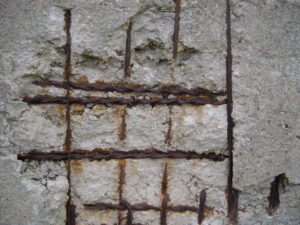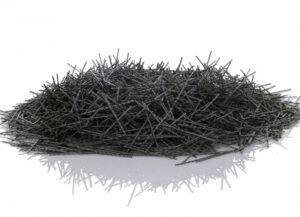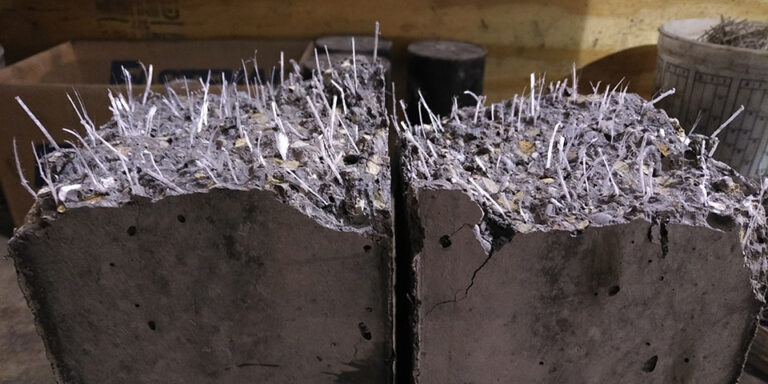Why replace a method that has been proven for 150 years? Focus on fiber-reinforced concrete.
Reinforced concrete is one of the cornerstones of modern society. Not just metaphorically, but literally.
Concrete itself is an incredibly strong material, as we all know. It can withstand extremely heavy loads if the load is evenly distributed over the surface.
However, if the load is concentrated on smaller points or if tensile stresses occur within the structure, it performs very poorly and breaks like glass.
Steel reinforcement addresses these limitations of concrete by significantly improving its flexural strength and distributing pressure from point loads.
However, it poses a completely new problem: the corrosion of the steel reinforcement is the most common cause of concrete degradation.
We all know that unprotected steel corrodes.
The rust that forms on its surface can undergo significant volumetric expansion, exerting pressure on the surrounding material much like ice does to glass.
The steel embedded in concrete is protected on several fronts: the concrete cover prevents moisture and oxygen, the sworn enemies of concrete reinforcement, from accessing it. Additionally, it also prevents the penetration of carbon dioxide, which is primarily responsible for concrete corrosion.
The other line of defense is the alkaline environment. The alkaline pH of the concrete creates a thin oxide layer around the steel reinforcement, preventing further corrosion.
These protective systems work as long as the layer of concrete covering the steel is thick enough and free from damage.
Not everyone is aware that concrete shrinks significantly during the curing process as water exits the structure: a portion of it is used by the concrete for cement binding, and a significant amount evaporates.
The shrinkage results in stresses that often cause concrete to crack. Microcracks, which are sometimes invisible to the naked eye, frequently form, while in other cases, cracks as large as several millimeters can be visible from afar.
These cracks are on the shield.
Through these cracks, water, oxygen, carbon dioxide, and other aggressive substances can reach the concrete reinforcement.
The third enemy of concrete is salt. The chloride ions that penetrate the structure when de-icing salts are used cause brutal damage to both the concrete and the concrete reinforcement within it.

The task, therefore, is to prevent the ingress of these harmful substances into the structure, thereby preventing the formation of microcracks on the surface and making the steel accessible.
For crack prevention, numerous additives have been developed. ArmoTec macro fibers are one of these, but they are not only used for crack prevention. Macro fibers can also be considered structurally and assist in load distribution, which is one of the weakest links in unreinforced concrete structures.
If it prevents shrinkage cracks during curing and assists in load distribution, then why use concrete reinforcement at all?
Because when a concrete structure needs to withstand bending loads, the macro fiber alone cannot replace the concrete reinforcement. However, if the task of the concrete reinforcement is load distribution, then yes.
In these structures, fiber-reinforced concrete can confidently be used to replace concrete reinforcement mesh.
- assembly concrete
- base concrete
- ground-level stairs
- carport
- slab foundation (with certain restrictions)
- pits
- filling of cobblestones
- sidewalks
- etc.

If there are no cracks and no concrete reinforcement, then the concrete thickness can also be reduced because there is no need for an extra 40-50 mm thickness just to cover the concrete reinforcement, as it is not present in the structure.
And the rest of the advantages are just the icing on the cake:
– Fiber-reinforced concrete strengthens the concrete in three dimensions at every single point, while the mesh is only in one plane.
– It significantly speeds up the construction process by replacing the work processes associated with concrete reinforcement mesh.
– It makes work safer by eliminating accidents arising from the use of concrete reinforcement mesh.
– ArmoTec
– It’s easy to work with. You simply need to add it directly into the concrete mixer—no transportation, no handling, no steelwork, no hassle.
– It’s easy to drill fiber-reinforced concrete, with no drill breakage.
– It’s much cheaper than concrete reinforcement mesh.
– It leaves a much smaller ecological footprint. Its production and transportation result in a fraction of the environmental pollution caused by concrete reinforcement mesh. Moreover, by replacing steel with this material, you can reduce the amount of corrosion-resistant concrete needed, further contributing significantly to environmental protection.
These are the reasons why the good old steel retirement period has begun.
If you also want to choose the new path instead of the outdated one, come and order ArmoTec in two minutes, and you can start concreting the day after tomorrow.
Fiber-reinforced concrete – simpler and cheaper concreting
Come, take a look here for a minute, and see the numerous advantages of fiber-reinforced concrete: ArmoTec static macro fiber video.








